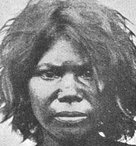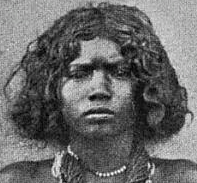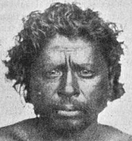Australo-Melanesian

In physical anthropology, forensic anthropology and archaeogenetics, Australo-Melanesians (variously also Australasian, Australoid, Australo-Veddoid or Veddoid)[1] form a large group of populations indigenous to Maritime Southeast Asia and Oceania, one of the world's four major ancestry groups, the other three being Caucasoid (West Eurasian), Mongoloid (East/Central Asian) and Negroid (sub-Saharan African).[2] The group includes Aboriginal Australians, Melanesians, the populations grouped as "Negrito" (the Andamanese, the Semang and Batek people, the Maniq people, the Aeta people, the Ati people, and various other ethnic groups in the Philippines), as well as certain tribes of India, the Vedda of Sri Lanka, and a number of tribal populations in the interior of the Indian subcontinent[3].
The term "Australioid race" was introduced by Thomas Huxley in 1870 to refer to certain peoples indigenous to South and Southeast Asia and Oceania.[4] Terms associated with outdated notions of racial types, such as those ending in "-oid" have come to be seen as potentially offensive[2] and related to scientific racism.[5][6]
Terminological history

The term "Australoid" was coined in ethnology in the mid 19th century, describing tribes or populations "of the type of native Australians".[7] In physical anthropology, Australoid is used for morphological features characteristic of Aboriginal Australians by Daniel John Cunningham in his Text-book of Anatomy (1902).
An Australioid (sic, with an additional -i-) racial group was first proposed by Thomas Huxley in an essay On the Geographical Distribution of the Chief Modifications of Mankind (1870), in which he divided humanity into four principal groups (Xanthochroic, Mongoloid, Negroid, and Australioid).[8] Huxley's original model included the native inhabitants of South Asia under the Australoid category. Huxley further classified the Melanochroi (Peoples of the Mediterranean race) as a mixture of the Xanthochroi (northern Europeans) and Australioids.[9] Huxley (1870) described Australioids as dolichocephalic; their hair as usually silky, black and wavy or curly, with have large, heavy jaws and prognathism, with skin of the color of chocolate and with irises that are dark brown or black.[10]
The term "Proto-Australoid" was used by Roland Burrage Dixon in his Racial History of Man (1923). In a 1962 publication, Australoid was described as one of the five major human races alongside Caucasoid, Mongoloid, Congoid and Capoid.[11]
In The Origin of Races (1962), Carleton Coon attempted to refine such scientific racism by introducing a system of five races with separate origins. Based on such evidence as claiming Australoids had the largest, megadont teeth, this group was assessed by Coon as being the most archaic and therefore the most primitive and backward. Coon's methods and conclusions were later discredited and show either a "poor understanding of human cultural history and evolution or his use of ethnology for a racialist agenda." [5]
Bellwood (1985) uses the terms "Australoid", "Australomelanesoid" and "Australo-Melanesians" to describe the genetic heritage of "the Southern Mongoloid populations of Indonesia and Malaysia". [12]
Since the 1980s, anthropological terms in "-oid" have come to be avoided in some disciplines, especially in the United States, where the term Australo-Melanesian is now preferred. In other areas, specifically in anthropological literature in India, the term Australoid continues to be preferred.[13]
Distribution
| Caucasoid race | |
| Congoid race | |
| Capoid race | |
| Mongoloid race | |
| Australoid race |
Besides the Australian Aboriginals, Melanesians and Negritos, the "Australoid" category is often taken to include various tribes of India. The inclusion of Indian tribes in the group is not well-defined, and is closely related to the question of the original peopling of India, and the possible shared ancestry between Indian and Australian populations of the Upper Paleolithic. The American Journal of Physical Anthropology (1996, p. 382) by American Association of Physical Anthropologists. L. L. (Luigi Luca) Cavalli-Sforza, Paolo Menozzi and Alberto Piazza in their text, The History and Geography of Human Genes (1994, P. 241) both use the term.
Tee suggested Australoid ancestry of the original South Asian populations has long remained an open question. It was embraced by Indian anthropologists as emphasizing the deep antiquity of Indian prehistory. Australoid hunter-gatherer tribes of the interior of India were identified with the Nishada Kingdom described in the Mahabharata. Panchanan Mitra (1923) following Vincenzo Giuffrida-Ruggeri (1913) recognizes a Pre-Dravidian Australo-Veddaic stratum in India.[14] Alternatively, the Dravidians themselves have been claimed as originally of Australoid stock,[15] a view held by Biraja Sankar Guha among others.[16]
South Indian tribes specifically described as having Australoid affinities include the Oraon, Munda, Santal, Bhil, Gondi, the Kadars of Kerala, the Kurumba and Irula of the Nilgiris, the Paniyans of Malabar, the Uralis, Kannikars, Mithuvan and Chenchus.[17] but other Indian anthropologists of the post-colonial period, such as S. P. Sharma (1971) and D. N. Majumdar (1946, 1965), have gone as far as claiming Australoid ancestry, to a greater or lesser extent, for all castes of India.[18]
Physical features
In physical anthropology, the Australo-Melanesian group is characterized primariliy by its characteristic dental morphology.[20] In Java, "Australo-Melanesian dentitions" are found in fossils until the mid-Holocene (c. 5,000 years ago), but are replaced by modern "Southern Mongoloid dentitions" (Sundadonty) in the Neolithic, suggesting the displacement of the aboriginal Australo-Melanesian population by the Austronesian expansion.[21]
Genetics
Numerous studies of archaeogenetics performed during 2009–2016 have suggested that Eurasian populations can be derived from an early division of the non-African lineage into an eastern and a western clade lineage before around 40,000 years ago.[22] It has been argued, however, that this model of a primary split between eastern and western Eurasians is invalid for Oceania and Southeast Asia.[23] The so-called "southern-route hypothesis" derives an Australasian lineage, comprising Australians, New Guineans, and possibly Southeast Asian Negritos, from an early out-of-Africa dispersal, forming an ancestral lineage which split off the other non-African lineages prior to the Eastern Eurasian vs. Western Eurasian split.[24] A number of 2016have presented a refined model of Australasian ancestry.[25] Reviewing the evidence, Lipson and Reich (2017) present as best-fitting model a derivation of the Australasian clade from the Eastern Eurasian clade at an early time, with sustantial Denisovan admixture (of the order of 4%) before the Ausralasian clade split into the Australian and the New Guinean lineages.[24]
Australoid components present throughout the Indian subcontinent and Southeast Asia is genetically closest to Negrito Andamanese Islanders.[26] Pugach et al. (2013) find an ancestral association between Aboriginal Australians, New Guineans and the Mamanwa Negritos, with an estimated divergence time of at least 35,000 years, in support of the "southern migration route" scenario. In addition, the study finds evidence of gene flow between India and Australia at a later time, an estimated 141 generations ago (i.e. roughly 3,000 to 4,000 years ago), suggesting a possible late migration wave to Australia.[27]
A 2006 CFSL research article which assessed "3522 individuals belonging to 54 (23 belonging to the Austroasiatic, 18 to Dravidian, 7 to Tibeto-Burman and 24 to Indo-European linguistic groups) endogamous Indian populations, representing all major ethnic, linguistic and geographic groups" for genetic variations to support such classifications found no conclusive evidence. It further summed that "the absence of genetic markers to support the general clustering of population groups based on ethnic, linguistic, geographic or socio-cultural affiliations" undermines the broad groupings based on such affiliations that exist in population genetic studies and forensic databases.[28] Australoid components present through Indian Subcontinent and Southeast Asia is genetically closest to Negrito Andamanese Islanders[29] though still divergent[30] however some Indians also have genetic links with Australian Aborigenes, though mixed with Caucasoid or Mongoloid genes as well.[31]
Possible early presence in the Americas

A speculative theory of Walter Neves in the 1990s proposes that an early Australoid population may have been the earliest occupants of the New World. The theory was based on an analysis of the Luzia Woman fossil found in Brazil, and found tentative academic support.[32]
If this hypothesis is correct, it would mean that some Australoid groups continued the Great Coastal Migration beyond Southeast Asia, along the continental shelf north in East Asia and across the Bering land bridge, reaching the Americas by about 50,000 years ago.
Genetic evidence
In 2015, two major studies of the DNA of living and ancient people detect in modern Native Americans a trace of DNA related to that of native people from Australia and Melanesia. Australasian admixture in some living Native Americans, including those of the Aleutian Islands and the Surui people of Amazonian Brazil. Evidence of Australasian admixture in Amazonian populations was found by Skoglund and Reich (2016).[33]
Walter Neves and Mark Hubbe argue that these people descended from an early wave of migration that was separate from the one that gave rise to today’s Native Americans, and drew on a different source population in Asia.[34]
Morphology
Christy Turner notes that "cranial analyses of some South American crania have suggested that there might have been some early migration of "Australoids."[35] However, Turner argues that cranial morphology suggests sinodonty in all the populations he has studied.
One of the earliest skulls discovered in the Americas by archaeologists is an Upper Paleolithic specimen named the Luzia Woman. According to Neves, Luzia's Paleo-Indian predecessors lived in South East Asia for tens of thousands of years, after migrating from Africa, and began arriving in the New World, as early as 15,000 years ago. Some anthropologists have hypothesized that Paleo-Indians migrated along the coast of East Asia and Beringia in small watercraft, before or during the LGM. Neves' conclusions have been challenged researchers who argued that the cranio-facial variability could just be due to genetic drift and other factors affecting cranio-facial plasticity in Native Americans.[36]
See also
References
- ↑ Luigi Luca Cavalli-Sforza, Paolo Menozzi, Alberto Piazza, The History and Geography of Human Genes (1994), p. 241. R. P. Pathak, Education in the Emerging India (2007), p. 137.
- 1 2 Black, Sue; Ferguson, Eilidh (2011). Forensic Anthropology: 2000 to 2010. Taylor and Francis Group. p. 127. Retrieved 3 July 2018. "There are considered to be four basic ancestry groups into which an individual can be placed by physical appearance, not accounting for admixture: the sub-Saharan African group ("Negroid"), the European group ("Caucasoid"), the Central Asian group ("Mongoloid"), and the Australasian group ("Australoid"). The rather outdated names of all but one of these groups were originally derived from geography"
- ↑ T. Pullaiah, K. V. Krishnamurthy, Bir Bahadur, Ethnobotany of India, Volume 5: The Indo-Gangetic Region and Central India (2017), p. 26 names: the tribes of Chota Nagpur, the Baiga, Gond, Bhil, Santal and Oroan tribes; counted as of partial Australoid and partial Mongoloid ancestry are certain Munda-speaking groups (Munda, Gadaba, Santals) and certain Dravidian-speaking groups (Maria, Muria, Gond, Oroan).
- ↑ Pearson, Roger (1985). Anthropological Glossary. Krieger Publishing Company. pp. 20, 128, 267. Retrieved 2 February 2018.
- 1 2 Fluehr-Lobban, C. (2005). Race and racism : an Introduction. Lanham : Rowman & Littlefield. p. 131-133.
- ↑ "Ask Oxford – Definition of Australoid". Oxford Dictionary of English. 2018. Retrieved 2018-06-28.
- ↑ J.R. Logan (ed.), The Journal of the Indian archipelago and eastern Asia (1859), p. 68.
- ↑ Huxley, Thomas On the Geographical Distribution of the Chief Modifications of Mankind. 1870. August 14, 2006
- ↑ Huxley, Thomas. On the Geographical Distribution of the Chief Modifications of Mankind. 1870. August 14, 2006. <http://aleph0.clarku.edu/huxley/SM3/GeoDis.html>
- ↑ Huxley, T. H. "On the Geographical Distribution of the Chief Modifications of Mankind" (1870) Journal of the Ethnological Society of London
- ↑ Moore, Ruth Evolution (Life Nature Library) New York:1962 Time, Inc. Chapter 8: "The Emergence of Modern Homo sapiens" Page 173 – First page of picture section "Man and His Genes": "The Australoid race is identified as one of the five major races of mankind, along with the Mongoloid, Congoid, Caucasoid, and Capoid races (pictures of a person typical of each race are shown)"
- ↑ Bellwood, Peter (1985). Prehistory of the Indo-Malaysian Archipelago. Australian National University. ISBN 978-1-921313-11-0.
- ↑ Ram Nath Sharma, Rajendra Kumar Sharma, Anthropology (1997), .
- ↑ P. Mitra, Prehistoric India (1923), p. 48.
- ↑ Sarat Chandra Roy (Ral Bahadur) (2000). Man in India - Volume 80. A. K. Bose. p. 59. Retrieved 21 May 2018.
- ↑ R. R. Bhattacharya et al. (eds., Anthropology of B.S. Guha: a centenary tribute (1996), p. 50.
- ↑ Mhaiske, Vinod M., Patil, Vinayak K., Narkhede, S. S., Forest Tribology And Anthropology (2016), p. 5. Bhuban Mohan Das, The Peoples of Assam (1987), p. 78.
- ↑ cited after Bhuban Mohan Das, The Peoples of Assam (1987), 77f. "Majumder also subscribes to this view by saying that 'the Australoid features are found throughout the length and breadth of Indian subcontinent'".
- ↑ Bellwood, Peter. Pre-History of the Indo-malaysian Archipelago. Australian National University:1985. ISBN 978-1-921313-11-0
- ↑ G. Richard Scott, Christy G. Turner II, Grant C. Townsend, María Martinón-Torres, "The Anthropology of Modern Human Teeth: Dental Morphology and Its Variation in Recent and Fossil Homo Sapiens", Cambridge University Press (2018), p. 260.
- ↑ S. Noerwidi, "Using Dental Metrical Analysis to Determine the Terminal Pleistocene and Holocene Population History of Java", in: Philip J. Piper, Hirofumi Matsumura, David Bulbeck (eds.), New Perspectives in Southeast Asian and Pacific Prehistory (2017), p. 92.
- ↑ "The former [eastern clade] includes present-day East Asians and had differentiated as early as the ∼40 kya Tianyuan individual (Fu et al. 2013), while early members of the latter [western clade] include ancient European hunter-gatherers (Lazaridis et al. 2014; Seguin-Orlando et al. 2014; Fu et al. 2016) and the ancient northern Eurasian Mal’ta 1 (MA1, a ∼24 kya Upper Paleolithic individual from south-central Siberia) (Raghavan et al. 2014). More recent (Neolithic and later) western Eurasians, such as Europeans, are mostly descended from the western clade but with an additional component of “Basal Eurasian” ancestry (via the Near East) splitting more deeply than any other known non-African lineage (Lazaridis et al. 2014, 2016). The timing of the eastern/western split is uncertain, but several papers (Gutenkunst et al. 2009; Laval et al. 2010; Gravel et al. 2011) have used present-day European and East Asian populations to infer dates of initial separation of 40–45 kya (adjusted for a mutation rate of 0.5 × 10−9 per year; Scally 2016)."
- ↑ Rasmussen, M., et al., "An Aboriginal Australian genome reveals separate human dispersals into Asia", Science 334(6052) (2011), 94-98, doi:10.1126/science.1211177. "We show that Aboriginal Australians are descendants of an early human dispersal into eastern Asia, possibly 62,000 to 75,000 years ago. This dispersal is separate from the one that gave rise to modern Asians 25,000 to 38,000 years ago."
- 1 2 Mark Lipson and David Reich, "A Working Model of the Deep Relationships of Diverse Modern Human Genetic Lineages Outside of Africa", Mol Biol Evol 34.4 (2017), 889–902, doi:10.1093/molbev/msw293.
- ↑ Mondal M, Casals F, Xu T, Dall’Olio GM, Pybus M, Netea MG, Comas D, Laayouni H, Li Q, Majumder PP., et al. 2016. "Genomic analysis of Andamanese provides insights into ancient human migration into Asia and adaptation", Nat Genet. 48(9): 1066–1070. Mallick S, Li H, Lipson M, Mathieson I, Gymrek M, Racimo F, Zhao M, Chennagiri N, Nordenfelt S, Tandon A., et al. 2016. "The Simons Genome Diversity Project: 300 genomes from 142 diverse populations", Nature 538(7624): 201–206. Malaspinas AS, Westaway MC, Muller C, Sousa VC, Lao O, Alves I, Bergström A, Athanasiadis G, Cheng JY, Crawford JE., et al. 2016. "A genomic history of Aboriginal Australia", Nature 538(7624): 207–214. Pagani L, Lawson DJ, Jagoda E, Mörseburg A, Eriksson A, Mitt M, Clemente F, Hudjashov G, DeGiorgio M, Saag L., et al. 2016. "Genomic analyses inform on migration events during the peopling of Eurasia", Nature 538(7624): 238–242.
- ↑ Moorjani P, Thangaraj K, Patterson N, Lipson M, Loh PR, Govindaraj P, Berger B, Reich D, Singh L, "Genetic evidence for recent population mixture in India", Am J Hum Genet. 2013 Sep 5;93(3):422-38, doi:10.1016/j.ajhg.2013.07.006
- ↑ Irina Pugach, Frederick Delfin, Ellen Gunnarsdóttir, Manfred Kayser, and Mark Stoneking, "Genome-wide data substantiate Holocene gene flow from India to Australia", PNAS January 29, 2013 110 (5) 1803-1808;doi:10.1073/pnas.1211927110.
- ↑ Kashyap, VK; Guha, S.; Sitalaximi, T.; Bindu, G.H.; Hasnain, S.E. & Trivedi, R. (2006). "Genetic structure of Indian populations based on fifteen autosomal microsatellite loci" (PDF). BMC Genetics. 7: 28. doi:10.1186/1471-2156-7-28. PMC 1513393. PMID 16707019.
- ↑ http://www.livescience.com/38751-genetic-study-reveals-caste-system-origins.html
- ↑ http://s1.zetaboards.com/anthroscape/topic/4846429/11/
- ↑ http://www.nature.com/news/genomes-link-aboriginal-australians-to-indians-1.12219
- ↑ Ancient voyage of discovery, Independent, The (London), Apr 8, 1996 by David Keys
- ↑ P. Skoglund, D. Reich, "A genomic view of the peopling of the Americas", Curr Opin Genet Dev. 2016 Dec; 41: 27–35, doi: 10.1016/j.gde.2016.06.016. "Recently, we carried out a stringent test of the null hypothesis of a single founding population of Central and South Americans using genome-wide data from diverse Native Americans. We detected a statistically clear signal linking Native Americans in the Amazonian region of Brazil to present-day Australo-Melanesians and Andaman Islanders (‘Australasians’). Specifically, we found that Australasians share significantly more genetic variants with some Amazonian populations—including ones speaking Tupi languages—than they do with other Native Americans. We called this putative ancient Native American lineage “Population Y” after Ypykuéra, which means ‘ancestor’ in the Tupi language family."
- ↑ Mysterious link emerges between Native Americans and people half a globe away by Michael Balter published in the "American Association for the Advancement of Science" on July 21, 2015
- ↑ Turner, Christy (2002). "Teeth, Needles, Dogs and Siberia: Bioarchaeological Evidence for the Colonization of the New World". The First Americans: The Pleistocene Colonization of the New World'. University of California Press. p. 138. ISBN 978-0-940228-50-4.
- ↑ Stuart J. Fiedel (2004). "THE KENNEWICK FOLLIES: "New" Theories about the Peopling of the Americas". Retrieved 2008-02-15.




